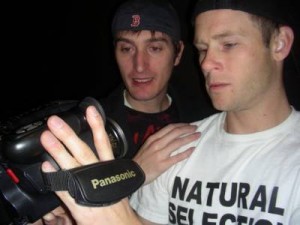
Of all the Los Angeles theater success stories of 2009, perhaps none was greater than that of The Columbine Project, Paul Storiale’s meticulously researched docudrama about the Columbine High School massacre of 1999. World premiering last April at the 48-seat Avery Schreiber theater in North Hollywood, The Columbine Project was extended twice before transferring to off-Broadway with unprecedented swiftness (and with the entire L.A. cast intact). Its July through October New York run at the Actors Temple Theatre was praised by the prestigious New Yorker magazine as a production which “fills the tiny, funky theatre with talent and gravity.” In December, the original North Hollywood production was awarded five ADA (Artistic Director Achievement) Awards including a Best Director award for its creator/writer/director Paul Storiale.
The Columbine Project has returned to the Avery Schreiber minus an hour of the original three-hour running time and with a new cast that comes close to matching the excellence of the original ensemble. Despite the cuts, virtually all of the most memorable scenes from the first production remain.
The play moves backwards and forwards in time, introducing us to Eric and Dylan’s teachers, classmates, and other Coloradans whose lives were changed forever on that April day.
We meet a TV reporter (Steve Rad) broadcasting live from the site of the massacre, his hand his hands trembling. “It is a war zone down here,” he declares over the sounds of helicopters circling above. “Information is very scarce now as the gunpersons are still at large.”
We meet Dylan’s childhood friend Brooks Brown (Cody Beverstock), a different sort of Columbine victim. “My friends did this and I was blamed for it, maligned and traumatized,” protests Brooks who, after the shootings, was offered a diploma in exchange for never going back to school again.
We meet Chris Taylor (Colin Bates), a gay student tormented by jocks and befriended by fellow student Rachel Scott (understudy Sara Swain). When Rachel finds a tearful Chris, she offers him Kleenex and sympathy. “God loves you for how he made you,” she tells him, revealing herself to be the kind of open, accepting Christian not usually depicted on stage, film, or TV. Rachel Scott would be Eric and Dylan’s first victim on that April day in 1999.
We meet Wayne and Kathy Harris (Timothy Brennan and Karen Praxel) and see, not the defective, easy-to-blame parents we are expecting, but a loving couple who found it all too easy to ignore the warning signs their son was exhibiting.
We meet lawyer Alice Sparks (Anna Mountford), hired by families of the victims. Why did it take so long for law enforcement officers to enter the school building? Why are there so many holes in the police reports? A teacher’s open cell phone recorded 26 minutes of what was taking place in the library. Why won’t the police let the families hear the tape?
We meet Eric’s well-intentioned but clueless psychiatrist Dr. Nice (Rad again), so taken in by Eric’s act that all he does is to prescribe drugs—to “level your head.”
We meet Vonda Shoels (Pamela Taylor), the mother of Isaiah Shoels, shot and killed for being a “nigger.” In tears, Vonda expresses how angry she still is at the teacher who could have done something by getting the students to barricade the library doors, but who spent five minutes with 911 before saving herself by hiding in a cupboard.
We meet Isaiah (Jordan Bellow), a boy who’d learned to use humor to get other kids to like him, telling his mother, “One day I’m going to be the President!” and we hear his proud mother’s reply. “Hold on to those dreams. You can be whatever you want to be.”
We meet Columbine High School teacher “Mrs. Miller” (Mountford again) who overhears jocks Seth and Jake calling Brooks “faggot,” and defying our expectations, reprimands Brooks for making the athletes angry. “They have a game next week!” she reminds him, her voice devoid of compassion for the real victim.
We meet other Columbine High School students (played by Tara Brown, Charlie Farr, Brett Fleisher, Jase Lindgren, Rachel Mattie Lane, and Anthony Storwick), who were part of Eric and Dylan’s life before April 20.
And most importantly, we meet the killers, Alpha Male Eric (Bryan Fox) and his disciple Dylan (Kevin Day). “They’re going to make video games about us!” Eric proclaims proudly. “Eric and Dylan, the real natural born killers!” We see the boys as they get ready for their killing spree and hear Eric’s shocking declaration, “I wish I was a fucking sociopath so I wouldn’t feel any remorse.” We see Eric, the quick and easy liar, tell his unsuspecting mother that the gun she spots in his room is a pellet gun for a movie he and Dylan are making. “Finish your movie and get back to school,” she tells her son with a goodbye kiss, oblivious to the fact the he and Dylan are about to go on their rampage.
Most of the cuts made in this production have been wise ones. The boys’ philosophy teacher isn’t missed, for example. Still, although three hours was entirely too long, even for a story of this density, the new shorter version loses something in the trimming, particularly the “you-are-there” library scenes. The one showing the teacher Mrs. Shoels vilified making that 911 phone call is especially missed. The original had the terrified teacher repeatedly telling the kids to stay under the tables as sounds of gunfire intensified. Also missed is a scene in which the sole faculty victim, a wounded coach, brought into the library to die. The play loses some impact without the horror of these scenes.
Fox and Day do excellent, frightening work as Eric and Dylan. Fox particularly is so real (and scary) that some audience members may have a hard time believing he’s an actor and not the dangerous sociopath he portrays. Beverstock is impressive as Brooks, delivering a powerful monolog in which he berates the police for doing nothing beforehand (despite the existence of a website in which Eric laid out his plans). Taylor has a devastating speech as Mrs. Shoals, one which she delivers exquisitely, leaving tears in both her own eyes and the audience’s. Original L.A. and New York cast member Swain makes for a lovely Rachel, Bellow shines in his brief scenes as Isaiah, and a fine Mountford creates two distinctive characters with but a word or two to hint that she’s a successful British TV and film actor. Brennan and Praxel make strong impressions as Eric’s parents, Rad is entirely believable in his three roles, and Brown, Farr, Fleisher, Lindgren, Lane, and Storwick do committed work as Eric and Dylan’s classmates. Finally, there is the enchanting Pasadena-born Bates, one of the original London Billy Elliots. Providing impeccable guitar accompaniment as he sings three moving and well-chosen songs, Bates makes an indelible impression as a boy coming to grips with his sexuality in a hostile environment.
The Columbine Project makes no attempt to excuse Eric Harris and Dylan Klebold for their actions, but it does help us understand, or at least gets us thinking about the possible reasons for two boys from “good” families to turn into monsters.
Jack Millard’s set design is a step up from the original production’s. Storiale’s lighting design is dramatic and effective. The script’s screenplay-like construction (plenty of short scenes in various locales) does make for many blackouts, however. Kudos to the skillful cast and stage manager Kelly Roane for moving furniture and other set pieces in and out as swiftly as possible (and in the dark). Still, despite a background of live radio broadcasts, police radio recordings, and heavy metal music (said by some to have fired Eric and Dylan’s rage), the many scene changes can’t help but slow down momentum. Also, leaving the two killers on the floor as their castmates take their bows might well be replaced with more traditional curtain calls.
Overall, there are plenty of reasons to spread the word about The Columbine Project’s return to L.A. Besides being a well-performed, written, and directed production, it focuses attention on the ever-present problem of bullying and violence in our country’s schools. The Columbine Project is sure to provoke much thought and discussion. Ultimately, it is an important reminder that what has happened before can happen again.
Avery Schreiber Theatre, 11050 Magnolia Blvd. NoHo Arts District, North Hollywood.
www.TheColumbineProject.com
–Steven Stanley
February 7, 2010




 Since 2007, Steven Stanley's StageSceneLA.com has spotlighted the best in Southern California theater via reviews, interviews, and its annual StageSceneLA Scenies.
Since 2007, Steven Stanley's StageSceneLA.com has spotlighted the best in Southern California theater via reviews, interviews, and its annual StageSceneLA Scenies.







 COPYRIGHT 2025 STEVEN STANLEY :: DESIGN BY
COPYRIGHT 2025 STEVEN STANLEY :: DESIGN BY